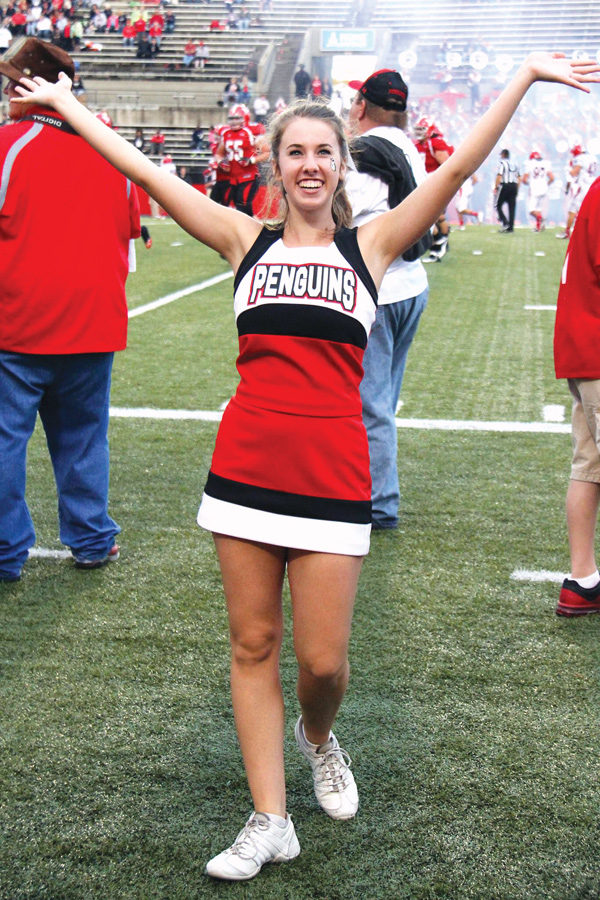Concussions in female athletes need more attention


Sarah Holloway, a cheerleader at YSU, has had four concussions: two from playing soccer and two from cheerleading.
By KARA PAPPAS
TheNewsOutlet.org
YOUNGSTOWN
Female athletes are more likely than males to get a concussion — and they take longer to recover, new research suggests.
Experts say there are a lot of unanswered questions, however. The biggest of which is why haven’t there been concussion studies that focus only on women in sports.
“Nobody has ever focused on female head injuries specifically,” said Katherine Snedaker, a concussion awareness expert from Connecticut. She has researched gender differences in concussions since 2008 and has posted results on her website, PinkConcussions.com.
From 1997-2012, nearly 1.2 million girls and women were treated nationwide in emergency rooms for sports-related concussions, according to data from the National Electronic Injury Surveillance System, which is operated by the U.S. Consumer Product Safety Commission.
Nearly one in 10 female athletes suffered injuries so severe they were hospitalized, the NEISS data shows.
Bicycling was the leading cause of female concussions with 173,571 emergency-room visits. Horseback riding was second, followed by soccer, basketball and softball.
So far, in terms of medical studies on concussions, female athletes are either not included or they are part of a study focusing on men.
A 2012 Reporting Information Online study on high-school athletes compared concussion rates in 20 different sports. The study concluded that females suffered more concussions than males and require a longer recovery time.
The RIO study, conducted by officials at The Research Institute at Nationwide Children’s Hospital in Columbus, was published in January 2012 in The American Journal of Sports Medicine.
“The RIO study found that the female-concussion rates are higher than the male-concussion rates when it comes to athletic head injuries,” Snedaker said. “And that study only looked at 100 high schools in the United States that actually have athletic trainers on staff.”
Without trainers, concussions in high school often go unnoticed, experts say. Still, in 2011, only a third of high schools in the U.S. with sports programs had a trainer on staff, according to the National Athletic Trainers Association.
Dr. Joseph Congeni, the director of sports medicine at Akron Children’s Hospital and a leader in concussion treatment in Northeast Ohio, said that data he’s seen does suggest that females suffer more concussions and take longer to recover.
“The major differences between male and female athletes with sports concussions tend to be that female athletes have less shoulder girdle and neck strength, which helps dampen the blow of a significant head or body shot,” he said.
Dr. Congeni said having athletic trainers at female sporting events and practices would help those athletes avoid concussions.
Athletic trainers educate players on techniques to play smart and avoid dangerous situations, he said. Also, if a female athlete suffers a concussion, the trainers can keep them out of the action to prevent further injury.
Schools can have 80 to 90 athletes participating in different sports at the same time, and the trainers are often dispatched to the football team leaving other sports uncovered, Dr. Congeni added.
Todd Burkey is one of six full-time athletic trainers at Youngstown State University. He said the potential risk and incidence of injury determines practice and game coverage by a trainer.
Burkey, who covers 18 varsity sports, has worked with the athletic department for 10 years, three of those years as an assistant athletic trainer.
“Those sports determined to be high risk of injury are assigned an athletic trainer that attends all practice sessions and games,” Burkey said.
Some sports, particularly those involving women athletes, often don’t get trainers’ attention because they aren’t considered a high risk for concussions.
Take cheerleading, for example.
Sarah Holloway, a freshman cheerleader at YSU, said her first concussion left her disoriented, confused and in pain.
“Not knowing where you are and why you have excruciating pain throughout your head is a horrible feeling,” she said.
Holloway has had four concussions: three in high school and one in college. Two were a result of soccer and two from cheerleading.
Holloway reacted differently to her first concussion than to her last.
“My first concussion was in a high-school soccer game where I was an hour away from home,” she said. “It was terrifying. I didn’t know anything about concussions other than it was a head injury.”
After that incident, Holloway researched concussions and brain injuries to help her understand what happened. In turn, she has educated other female athletes on the potential risks involved with head trauma.
After learning about those risks, Holloway said she has learned to play smarter and hopes more female athletes educate themselves on the symptoms of concussions.
“I think that female athletes should be aware of how easily it is to receive a concussion, but not let the fear of a concussion keep them from doing something that they love,” she said.
TheNewsOutlet.org is a collaborative effort among the Youngstown State University journalism program, The University of Akron, Cuyahoga Community College and professional media outlets including, WYSU-FM Radio and The Vindicator, and The Beacon Journal and Rubber City Radio of Akron.
 43
43
